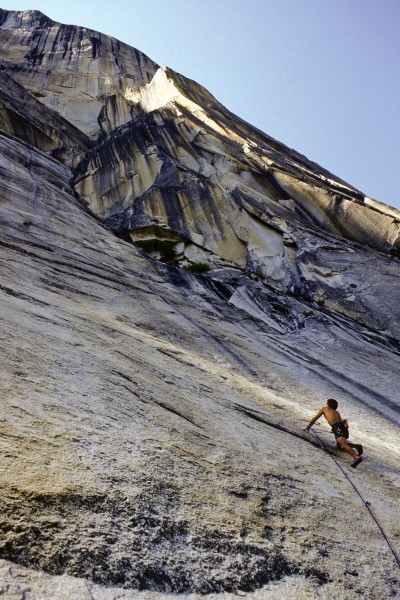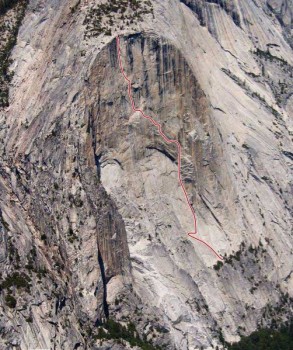By Chris McNamara and Brooke Sandahl
Mt Watkins - South Face FFA: May 28 – June 4
In late spring of 1996, Brooke Sandahl and Canadian Steve Sutton made the first free ascent of this uber classic, big wall hidden deep within the Tenaya Canyon. Although the South Face of Watkins is only a scant few hours hike from the main Valley, it has a wild and remote feel to it. The original route (South Face) was first ascended by the rough and ready crew of Warren Harding, Chuck Pratt and Yvon Chouinard, and in 1964 was one of the last remaining unclimbed big walls (@ 2800’) that afforded a challenge comparable with El Cap. For Sutton it was an especially significant ascent because he made the 3rd or 4th ascent decades earlier before cams and modern clean aid gear. Says Sutton, "We nailed every inch of the bloody thing", referring to his original aid ascent. For Sandahl (who had never been on it), this climb was part of his dream to walk up to a Grade VI big wall and make a ground up first free ascent: something that had never been done on a wall of that caliber. After carefully scrutinizing photos of the wall and talking with friends who had done the route and acknowledging that Mark Hudon and Max Jones had freed quite a lot it, “Steve and I felt ready to give it a go”. According to Sandahl, “much of the climbing is fairly moderate, and by the look of it, there were not too many desperate pitches, so it seemed like the odds were in our favor for an all free ascent”.
The route begins with 800 feet of fun corners and slabs (climbing up to 5.8), then gets down to business. The original line climbs up an easy 5th class trough and then down pendulums 2 pitches. They managed to free the first pendulum pitch (12a down climbing & traversing), but the second pendulum was hold less 5.13(?) slab, so the pair rapped down and found a very direct free variation (5.11d/12a) that takes you to the exact same ledge, without all the pendulums! Sutton, a master slab climber, won the coin toss and casually hiked the 1st pitch. For those who like polished, low angle slab, with few actual holds…this is your baby…classic Valley slab!
From there, the pair ascended the route to Sheraton Watkins ledge pitch 8, replacing the ancient and failing anchors as they went. Climbing the choice Double Cracks pitch off Sheraton Watkins, they were able to climb right (at the very end of the pitch (9)) via sweet, golden granite face holds, bypassing 2 old aid bolts on the original line. The next big question mark came where the original route made a large pendulum left and down to a ledge (pitch 13). The Pendulum Bypass pitch avoids this by climbing up and left, with pumpy, technical climbing and three distinct cruxes at around 5.12c/d. A few pitches later we arrived at the crux of the entire route, which takes an independent line out right, bypassing a bolt ladder on the original line. It’s a burly dyno, 2000 ft off the deck (describing the crux of the Boulder Problem pitch), that took Sandahl multiple tries to finally stick. Says Sandahl, “I could hit the edge every time, but kept raking off it. Knackered, after 6 days of climbing, cleaning and drilling in hot weather, I asked Stevo if we could spend another day. After a nights rest and in cooler conditions I finally stuck it”! How hard was it? According to Sandahl, "How do you rate a boulder problem in middle of big wall? It's business for sure. You do an all points off throw giving it everything." He rated it 5.13a (admittedly a stab at a number), but Tommy Caldwell, when he repeated it (May 2010) felt it was at least V8/9 which makes it more like 5.13+! Sandahl goes on to say, “it was just the coolest thing for me personally, to follow this circuitous path up this gigantic wall and to literally have to jump between the holds to link the bottom two thirds of the route with the upper third. I mean how wild is that? One small blank section that came so close to shutting us down…but didn’t”!
Now all free to pitch 15, only one question mark remained…a small aid section on the very last pitch. The final crux came just below the massive, looming summit roof a mere 60 feet from the top. But unfortunately, after eight days on the wall, the pair had run out of water. “Using our last bit of water that morning for a small pot of espresso” according to Sutton, they hammered up the final pitches and aided the last section, on the final pitch (of the original route) to the summit. “We were stoked to have come so close, but ultimately, didn’t pull off the single push…such as life”! According to Brooke, “I could see around the corner, while I aided the last bit, that under the giant summit visor, a free variation looked feasible. A few days later we hiked back in from Tuolumne and freed the last pitch, which as it turns out is a real stunner! Sandahl describes it as "tiny, tiny hold face climbing out a slab, to a barn door layback, on an outside-corner (5.12a)”, making it one of the most exposed big walls top outs in Yosemite. So classic!
While the pair didn't quite free the whole route in one ground up push, they were instrumental in advancing the ground up style of climbing and established one of the hardest big wall free climbs in the world at the time. Today, it is almost unheard of for a hard free route to be climbed ground up without extensive top-roping, after rappelling in from the top. Both climbers swung leads and all the pitches were led and followed free. Two pitches were not climbed redpoint: Sandahl followed the Pendulum Bypass (p 13) to make the first free linkage and the Boulder Problem pitch (15) was climbed from the ledge at the jump to the following anchor. Dean Potter made the 2nd free ascent (1st redpoint) and jumped off the summit to boot! Potter thought it to be maybe his favorite free wall in all of Yosemite!
The pair had this to say about the South Face of Watkins. “It’s a lost world up there in the Tenaya Canyon, massive trees, crystal clear waters and huge walls of immaculate stone and a pocket of nature holding on against mans onslaught. It gets you out of the hard-used central Valley and gives one a glimpse of what Yosemite must have been like before it got turned into the circus freak show that it is in contemporary times”. Say Sandahl, “it's one of my favorite routes in the Yosemite because it gets you out of the Valley. We were up there for 8 days and didn’t see another person." With many classic pitches and much varied climbing, from perfect splitters, to near hold less slabs and even a wild boulder problem high on the face, you’ll get your moneys worth for sure, plus there are great ledges at the end of nearly every pitch.
Those willing to invest in a small approach (by mountain standards) will be richly rewarded. Today the route is seeing more and more free climbing action both by people who want to free the whole route and those who just want to free the 80% of the climb that is 5.10+ or easier.

